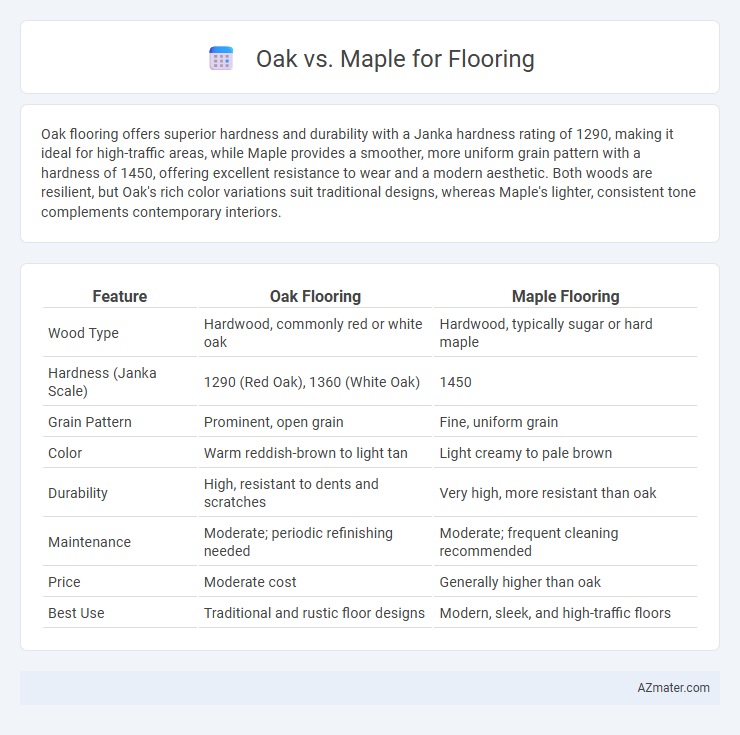Oak flooring offers superior hardness and durability with a Janka hardness rating of 1290, making it ideal for high-traffic areas, while Maple provides a smoother, more uniform grain pattern with a hardness of 1450, offering excellent resistance to wear and a modern aesthetic. Both woods are resilient, but Oak's rich color variations suit traditional designs, whereas Maple's lighter, consistent tone complements contemporary interiors.
Table of Comparison
| Feature | Oak Flooring | Maple Flooring |
|---|---|---|
| Wood Type | Hardwood, commonly red or white oak | Hardwood, typically sugar or hard maple |
| Hardness (Janka Scale) | 1290 (Red Oak), 1360 (White Oak) | 1450 |
| Grain Pattern | Prominent, open grain | Fine, uniform grain |
| Color | Warm reddish-brown to light tan | Light creamy to pale brown |
| Durability | High, resistant to dents and scratches | Very high, more resistant than oak |
| Maintenance | Moderate; periodic refinishing needed | Moderate; frequent cleaning recommended |
| Price | Moderate cost | Generally higher than oak |
| Best Use | Traditional and rustic floor designs | Modern, sleek, and high-traffic floors |
Introduction: Oak vs Maple Flooring
Oak flooring offers exceptional durability and a rich, warm grain pattern, making it a popular choice for high-traffic areas. Maple flooring provides a lighter, more subtle grain with a smooth texture, ideal for creating a modern, clean aesthetic. Both hardwood options deliver long-lasting performance, with oak known for its hardness rating of 1290 (Janka scale) and maple slightly harder at 1450, influencing resistance to dents and scratches.
Appearance and Grain Patterns
Oak flooring showcases prominent grain patterns with deep, swirling textures that range from straight to wavy lines, offering a classic and rustic aesthetic. Maple flooring features a finer, more uniform grain with subtle, consistent patterns that create a smooth, elegant appearance ideal for modern and contemporary interiors. Both hardwoods provide distinct visual characteristics, with oak's dramatic grains contrasting maple's soft, understated look.
Durability and Hardness Comparison
Oak flooring is renowned for its excellent durability and hardness, with a Janka hardness rating around 1290 for red oak and 1360 for white oak, making it highly resistant to dents and scratches. Maple offers even greater hardness, with a Janka rating of approximately 1450, resulting in superior resistance to wear in high-traffic areas. Both woods provide strong options for flooring, but maple's increased hardness may offer enhanced longevity in demanding environments.
Color Variations and Staining
Oak flooring offers a wide range of natural color variations from light beige to rich reddish-brown, making it versatile for various interior styles; its open grain absorbs stains evenly, resulting in consistent finishes. Maple flooring features a finer, more uniform grain with naturally lighter hues, such as creamy white to pale yellow, which can darken significantly with staining yet sometimes resist deeper penetration due to its dense hardness. Both woods respond well to staining, but oak's porous texture allows for more dramatic color customization, while maple's smooth surface provides a sleek, modern look with subtle tonal changes.
Cost Differences
Oak flooring generally costs between $6 to $12 per square foot, making it a moderately priced option known for durability and classic appeal. Maple flooring prices range from $7 to $15 per square foot, often higher due to its harder surface and lighter, modern aesthetic. Choosing between oak and maple depends on budget considerations alongside desired hardness and color preferences.
Maintenance and Care
Oak flooring offers superior durability and is highly resistant to wear, making it easier to maintain with regular sweeping and occasional polishing. Maple floors, while providing a smooth and attractive finish, require more frequent cleaning to prevent scratches and are more sensitive to moisture, demanding prompt spill cleanup. Both hardwoods benefit from maintaining stable indoor humidity levels to prevent warping and ensure long-term preservation.
Installation Considerations
Oak flooring offers greater installation versatility due to its hardness and stability, making it suitable for nail-down, staple, or glue-down methods across various subfloors. Maple, being denser and harder, requires more precise acclimation and often benefits from professional installation to prevent issues like cupping or cracking. Both hardwoods demand proper moisture control and acclimation periods of at least 48-72 hours to ensure optimal performance and longevity in flooring applications.
Suitability for Different Home Styles
Oak flooring offers a versatile and timeless aesthetic that complements traditional, rustic, and transitional home styles with its prominent grain patterns and warm tones. Maple flooring features a smoother, more subtle grain and lighter color palette, making it ideal for modern, contemporary, and minimalist interiors seeking a clean, sleek look. Both hardwoods provide durability and can be finished in various shades to enhance the architectural style and ambiance of diverse living spaces.
Pros and Cons of Oak Flooring
Oak flooring offers exceptional durability and a classic grain pattern that enhances both traditional and modern interiors. Its hardiness resists dents and scratches, making it ideal for high-traffic areas, while the natural color variations provide versatile design options. However, oak can be prone to moisture damage if not properly sealed, and it may darken over time, requiring periodic refinishing to maintain its appearance.
Pros and Cons of Maple Flooring
Maple flooring offers a smooth, durable surface with a light, uniform grain that brightens any room, making it ideal for modern and minimalist interiors. Its hardness provides excellent resistance to dents and scratches, yet it is more susceptible to moisture damage and can darken over time when exposed to sunlight. While maple is typically less expensive than exotic hardwoods, it requires regular maintenance and may lack the distinct grain pattern preferred by some homeowners compared to oak.

Infographic: Oak vs Maple for Flooring
 azmater.com
azmater.com